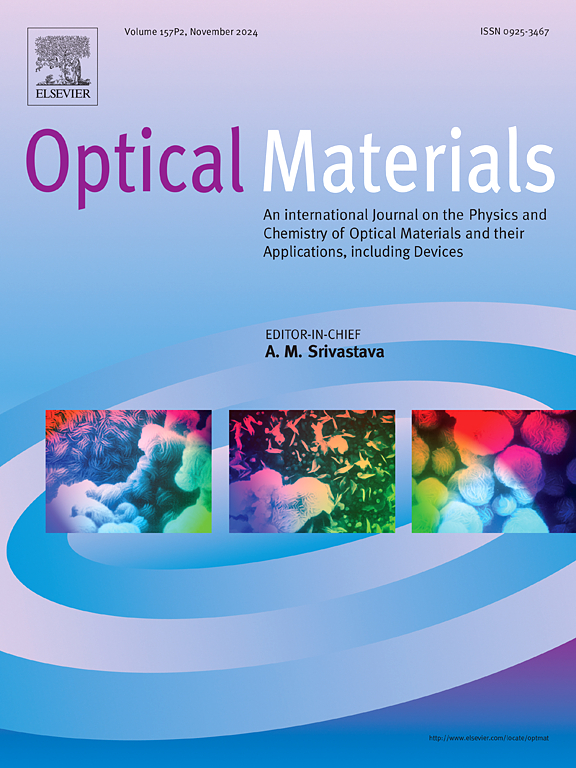硼碲锌玻璃系统的弹性和辐射屏蔽特性:氧化钆的影响
IF 3.8
3区 材料科学
Q2 MATERIALS SCIENCE, MULTIDISCIPLINARY
引用次数: 0
摘要
本研究利用公式[(TeO2)70(B2O3)30],探讨了 Gd2O3 对锌硼玻璃的弹性和辐射屏蔽特性的影响。采用熔融淬火技术制作了含有 1-5% mol% Gd2O3 的玻璃样品。XRD 验证了它们的非晶性质,红外光谱揭示了 TeO3、TeO4、BO3 和 BO4 振荡基团的存在。纵向和剪切超声波速度范围分别为 3908-4076 m/s 和 2222-2277 m/s,表明了结构的改变。随着 Gd2O3 含量的增加,玻璃的刚性得到改善,体积弹性模量(45 GPa)、纵向弹性模量(80 GPa)、剪切弹性模量(25 GPa)和杨氏模量(60 GPa)都有大幅提高。根据 WinXcom 的测量,Gd2O3 的浓度越高,质量衰减系数(μρ)就越大,从而增强了伽马射线屏蔽效果。0.662 MeV 时的半值层(HVL)和平均自由路径(MFP)随着 Gd2O3 的增加而一致下降。含 5 摩尔 Gd2O3 的玻璃具有最大密度和最佳伽马射线屏蔽性能。这些结果表明,Gd2O3 能够影响玻璃网络的弹性和辐射屏蔽效率,因此可用于需要更高硬度和更好辐射防护的应用领域。本文章由计算机程序翻译,如有差异,请以英文原文为准。
Elastic and radiation shielding properties of zinc borotellurite glass systems: The impact of gadolinium oxide
Using the formula [(TeO2)70(B2O3)30], this study examines the impact of Gd2O3 on the elasticity and radiation shielding characteristics of zinc borotellurite glass. Glass samples containing 1–5% mol% Gd2O3 were created by employing the melt quench technique. XRD verified that they are amorphous in nature, and the existence of TeO3, TeO4, BO3, and BO4 vibrational groups was revealed by infrared spectra. The structural alterations were shown by the range of longitudinal and shear ultrasonic velocities, which were 3908–4076 m/s and 2222–2277 m/s, respectively. The glass's rigidity was improved by the large rise in elastic moduli, such as bulk (45 GPa), longitudinal (80 GPa), shear (25 GPa), and Young's moduli (60 GPa), with a higher Gd2O3 content. Higher concentrations of Gd2O3 resulted in a rise in the mass attenuation coefficient (μρ), as measured by WinXcom, which enhanced gamma-ray shielding. The half-value layer (HVL) and mean free path (MFP) at 0.662 MeV decreased with increasing Gd2O3 in a consistent manner. The maximum density and optimum gamma-ray shielding performance were found in the glass containing 5 mol% Gd2O3. These results show Gd2O3 for applications needing greater rigidity and better radiation protection by demonstrating how it affects the elastic and radiation-shielding efficiency of the glass network.
求助全文
通过发布文献求助,成功后即可免费获取论文全文。
去求助
来源期刊

Optical Materials
工程技术-材料科学:综合
CiteScore
6.60
自引率
12.80%
发文量
1265
审稿时长
38 days
期刊介绍:
Optical Materials has an open access mirror journal Optical Materials: X, sharing the same aims and scope, editorial team, submission system and rigorous peer review.
The purpose of Optical Materials is to provide a means of communication and technology transfer between researchers who are interested in materials for potential device applications. The journal publishes original papers and review articles on the design, synthesis, characterisation and applications of optical materials.
OPTICAL MATERIALS focuses on:
• Optical Properties of Material Systems;
• The Materials Aspects of Optical Phenomena;
• The Materials Aspects of Devices and Applications.
Authors can submit separate research elements describing their data to Data in Brief and methods to Methods X.
 求助内容:
求助内容: 应助结果提醒方式:
应助结果提醒方式:


